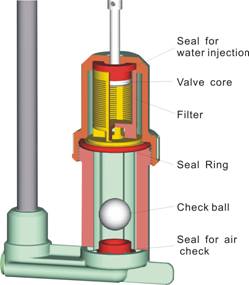Table of Contents
Advantages of Multi Jet Control Valves in Industrial Applications
Multi jet control valves have become indispensable components in various industrial applications, offering a plethora of advantages that enhance efficiency, accuracy, and control. These valves, designed to regulate the flow of fluids in systems with precision, have revolutionized numerous sectors, including manufacturing, chemical processing, water treatment, and beyond. Their versatility and reliability make them a preferred choice for engineers and operators seeking optimal performance and cost-effectiveness.
One of the primary advantages of multi jet control valves lies in their ability to maintain consistent flow rates across varying operating conditions. Unlike traditional valves that may struggle with fluctuations in pressure or flow, multi jet control valves excel in providing steady, uniform flow regardless of changes in system parameters. This ensures consistent process outcomes, reduces the risk of equipment damage, and enhances overall system reliability.
Moreover, multi jet control valves offer exceptional accuracy in flow control, enabling operators to achieve precise flow rates tailored to specific requirements. This level of control is critical in industries where even minor deviations from target parameters can Lead to costly inefficiencies or product defects. By accurately regulating flow, these valves contribute to improved product quality, increased throughput, and reduced waste, thereby driving operational excellence.
| Model | Central tube | Drain | Brine tank connector | Base | Maximum power | Operating temperature\u00a0 |
| 2850 | 1.9″(1.5″)O.D. | 1″NPTM | 3/8″&1/2″ | 4″-8UN | 72W | 1\u2103-43\u2103 |
Another notable advantage of multi jet control valves is their versatility in handling a wide range of fluids, including corrosive Chemicals, abrasive slurries, and high-viscosity liquids. Their robust construction and compatibility with various materials make them suitable for diverse applications across different industries. Whether tasked with controlling the flow of aggressive solvents in chemical processing plants or managing the distribution of purified water in municipal treatment facilities, these valves demonstrate exceptional performance and longevity.
Furthermore, multi jet control valves often incorporate advanced features such as digital control interfaces, remote monitoring capabilities, and predictive maintenance algorithms. These smart functionalities empower operators with real-time insights into valve performance, enabling proactive maintenance strategies and minimizing downtime. By leveraging data-driven insights, organizations can optimize asset utilization, extend equipment lifespan, and reduce lifecycle costs over time.
In terms of installation and maintenance, multi jet control valves offer notable advantages compared to traditional valve designs. Their modular construction and standardized components simplify installation procedures, reducing labor costs and time-to-deployment. Additionally, routine maintenance tasks such as inspection, cleaning, and calibration can be performed efficiently, minimizing disruption to operations and maximizing asset availability.
In conclusion, the advantages of multi jet control valves in industrial applications are manifold, encompassing precision, reliability, versatility, and advanced functionality. By providing consistent flow control, exceptional accuracy, rapid response times, and compatibility with various fluids, these valves contribute to enhanced operational efficiency, product quality, and cost-effectiveness. As industries continue to evolve and demand greater performance from their systems, multi jet control valves stand as indispensable tools for achieving optimal process control and productivity.
How to Optimize Performance and Efficiency of Multi Jet Control Valves
Multi jet control valves play a crucial role in various industries where precise control of fluid flow is essential. From water treatment plants to industrial processes, these valves are instrumental in regulating the flow of liquids with accuracy and efficiency. However, to ensure optimal performance and efficiency, it is essential to understand how to properly utilize and maintain these valves.
One of the key aspects to consider when optimizing the performance of multi jet control valves is proper sizing and selection. These valves come in a variety of sizes and configurations, and selecting the right one for a particular application is crucial. Factors such as flow rate, pressure, temperature, and the type of fluid being handled must be taken into account during the selection process. Choosing a valve that is properly sized and suited to the specific requirements of the system will help ensure smooth operation and minimize energy consumption.
Once the appropriate valve has been selected, proper installation is paramount. It is essential to follow the manufacturer’s guidelines and recommendations for installation to ensure that the valve operates correctly. Proper alignment, connection, and sealing are critical to prevent leaks and ensure optimal performance. Additionally, the installation location should be chosen carefully to minimize pressure drops and turbulence, which can affect the efficiency of the valve.
Regular maintenance is another key factor in optimizing the performance and efficiency of multi jet control valves. Routine inspection and servicing help identify and address any issues before they escalate into more significant problems. This includes checking for leaks, inspecting valve components for wear and tear, and lubricating moving parts as needed. Keeping the valve clean and free of debris is also essential for ensuring smooth operation and preventing Clogs or blockages.
In addition to maintenance, proper calibration is essential for maximizing the performance of multi jet control valves. Over time, factors such as changes in pressure, temperature, and flow rates can affect the accuracy of the valve. Regular calibration helps ensure that the valve maintains its desired performance characteristics and operates within specified tolerances. This can help prevent issues such as over or under-dosing of chemicals, which can impact the efficiency of the system.
Furthermore, integrating advanced control and Monitoring Systems can enhance the performance and efficiency of multi jet control valves. These systems allow for real-time monitoring of valve performance, enabling operators to detect and address issues promptly. Additionally, advanced control algorithms can optimize valve operation based on changing process conditions, further improving efficiency and reducing energy consumption.
In conclusion, optimizing the performance and efficiency of multi jet control valves requires careful consideration of various factors, including proper sizing and selection, installation, maintenance, calibration, and integration of advanced control systems. By following best practices and implementing proactive maintenance strategies, operators can ensure that these valves operate reliably and efficiently, contributing to overall system performance and productivity.

